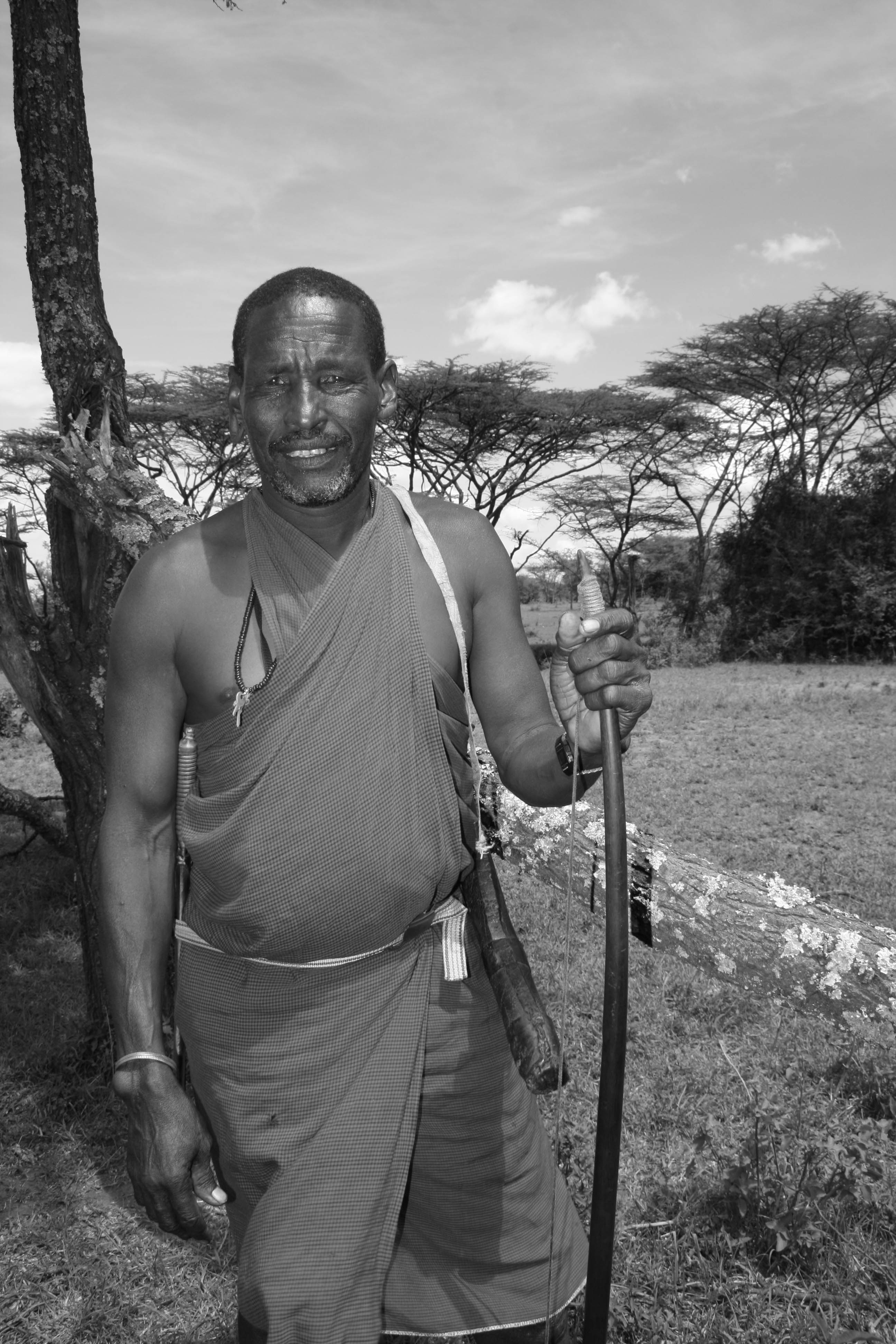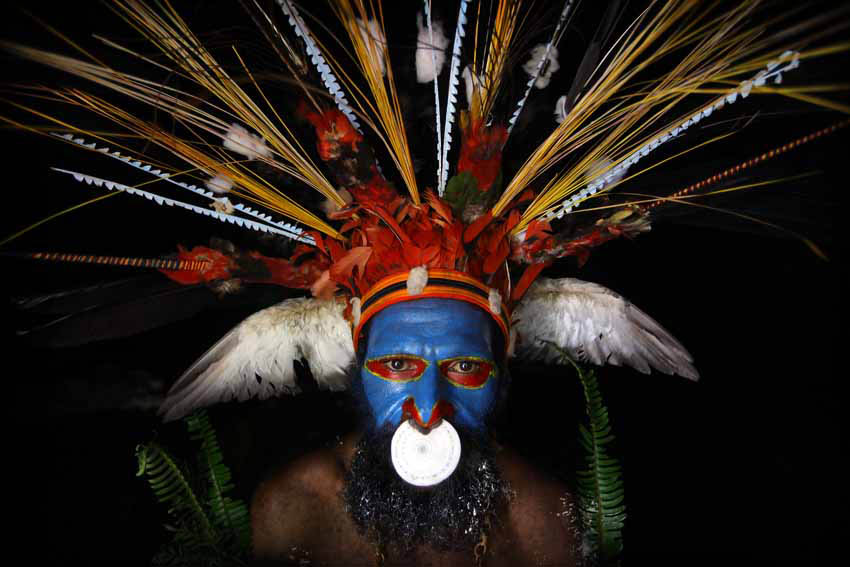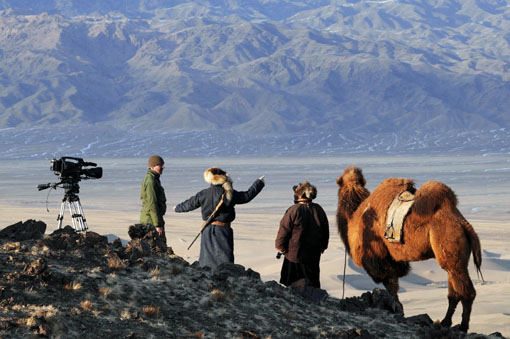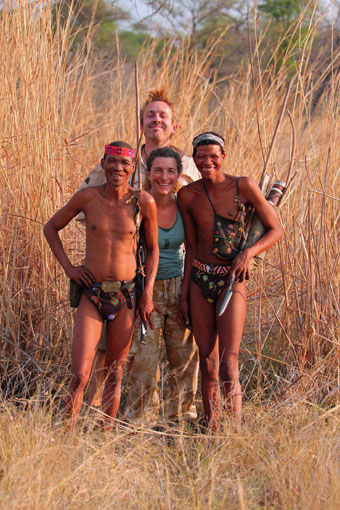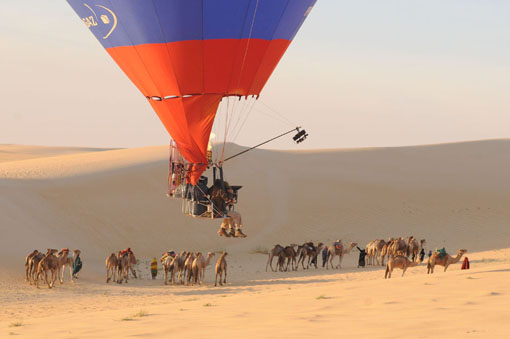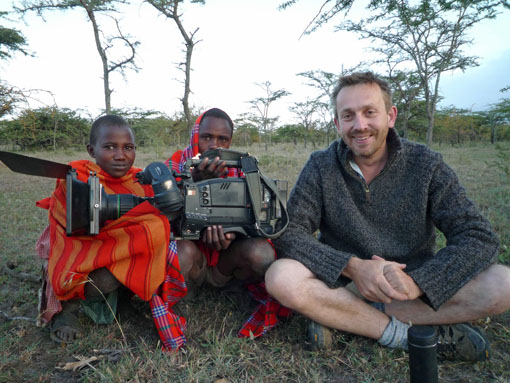The End and the Beginning of Human Planet
by Dale Templar, Series Producer
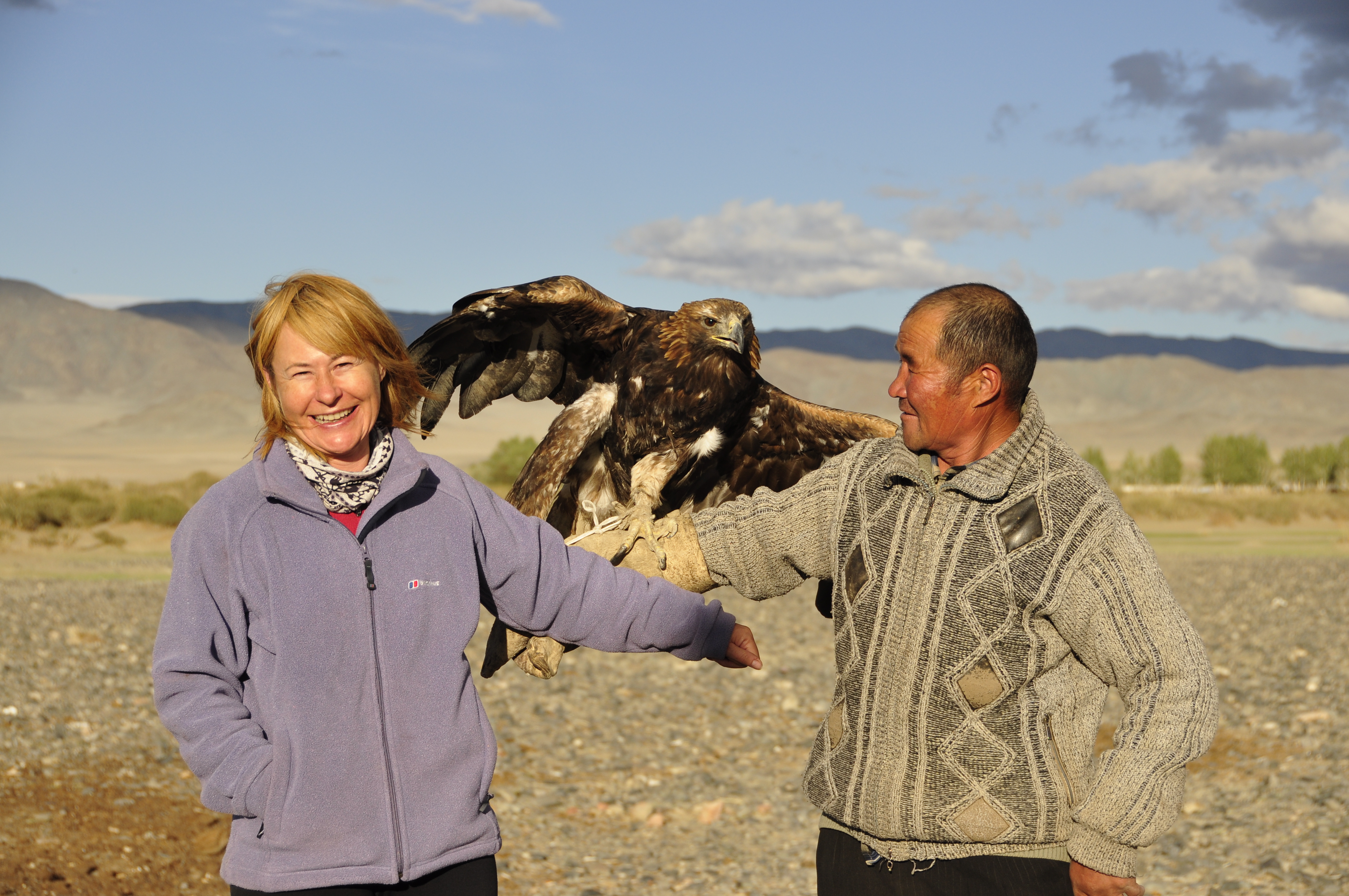
Dale pictured in Mongolia on a shoot to film the Eagle Hunters sequence from the Mountains programme.
Last Thursday saw the final episode of Human Planet transmit in the UK. I had mixed feelings as I watched the end credits roll for the last time. After three intense years, sending teams to over 70 locations including some of the remotest places on earth, this really did mark the end of the formal production process on the series. It is always sad when a production ends. Virtually all of my amazingly talent team have gone - many already on new adventures around the world. There is literally just a handful of us left in the Bristol and Cardiff offices.
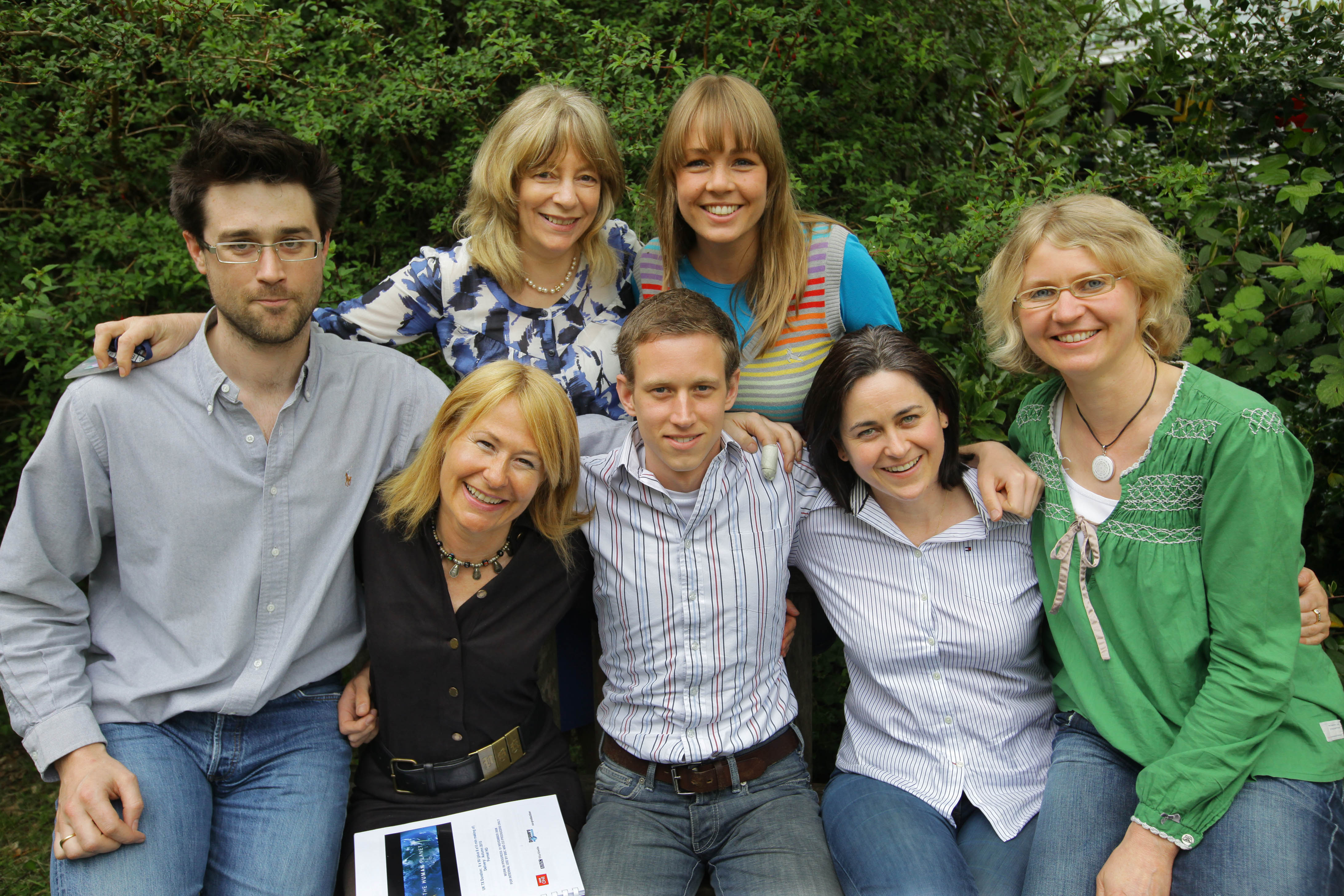
Dale with some of the Human Planet team. From left - right (front) Edit Assistant Craig Haywood, (Dale), Technical Co-ordinator Jasper Montana, Production Co-ordinator Isabelle Corr, Production Manager Alison Brown-Humes. (Back) Production Management Assistant Julia Wellard, Production Co-ordinator Jo Manley (Photo copyright Timothy Allen 2010)
But Human Planet has been different from any other programme I have ever worked on. Normally the last UK transmission would be the end of the series. For Human Planet it feels like a new beginning. For a start I am still in slight shock at the amazingly intense and positive reaction we have had to the series from people of all age groups. The series has been praised by members of the Royal Geographical Society, it’s been the focus of talk and gossip around office water coolers and it’s been making news particuarly online. I’m especially pleased that the series has connected with a younger audience - there’s been a buzz on Twitter and Facebook and millions of hits on You Tube. One young mum told me her 3 year old son was a huge fan of Human Planet, watching every episode without fail! No programme maker can ever be sure of a hit. This is a very fickle industry and audiences can never be guaranteed even when you’ve made a landmark series for the BBC. The feeling is that Human Planet is a fresh and different type of landmark. Many people, even those who don’t normally enjoy natural history have become hooked on humans!
Personally I hope this new found passion for humanity will continue. The series is a spectacular snapshot of the diverse human world we live in. But the world is changing fast, very fast. It’s becoming increasingly hermogenised. Even now one City looks much like the next - same Starbucks , same McDonald’s. Human Planet filmed with people who still directly depend on the natural world for their survival but their wisdom and customs may soon be disappear. The human species cannot be set in aspic but I think many of the stories we filmed will be gone within the next 10 years.
So what next? The series is now out on DVD/Blu-Ray and the book is in the shops. Next month it jumps across the Atlantic to be shown on Discovery Channel (a different version from the one showing in the UK) Then the UK version will start being shown on television around the world. So look out for Human Planet in your neck of the woods! Hopefully the BBC will commission a second series, watch this space…
So hopefully the end is truly just the beginning…I can only hope that this series sparks an interest in the challenges facing our human planet and that more is done to protect the incredible diversity, languages and cultures of our magnificent species.
Long live the Human Planet and all that sail on her!
Living with Lions
by Jane Atkins, Human Planet Researcher
‘You see, Lions and the Dorobo, we feed each other.’
‘If we hunt a large animal, we take away as much as we can, but leave the rest for the lions to feed on. And sometimes the lions kill a really fat animal and we say, lets take this one. It is not simple, you have to track carefully and quietly. You are scared.. thinking - will I be mauled?’
‘But when you are hungry and know lions have killed first - you take your chance. There are days when we eat only what the lion has killed. We live on those lion kills until we finally make our own kills.
When we filmed 3 Dorobo hunters stride up to 15 lions to steal from their fresh kill our hearts were in our mouths. Courageous? Ingenious? Suicidal? All of these perhaps, but this one act is undeniably impressive. The Dorobo say they are hunters just like lions. They watch lions, and how they hunt. Just as lions do, the Dorobo watch every animal on the great plains - and study each individual. Like lions they observe which ones are wounded, slower, easier to pick off. They wait and wait until the time is right to hunt. And if the lion gets there first, well the Dorobo turn that into another opportunity.

There are three lion prides living in the same area as the Dorobo. This 22 strong pride are just a few hundred metres from the Dorobo's regular camp.
But these opportunities are fading, and fast. These hunting and scavenging practices may be age old, but in 21st Century Kenya, they are banned under the country’s blanket law that no hunting is allowed in Kenya. Although the law was made primarily for big game hunters, it has been enforced at the local level, with traditional tribes, to avoid any ‘grey’ areas.
And so these Dorobo men are living a daily struggle of holding onto a lifestyle passed down through the generations; being free to walk through the great plains, hunt game to feed themselves and their family and sleep under the stars in caves and hidden valleys. Now, they all accept that although they were brought up to be hunters, they will not be bringing up their children to be hunters, to know the wildlife as intimately as they do.
Olkinyei is one of the last pockets in Kenya where the Dorobo still live, but in the last year, the area has been identified as a new conservancy, which means a step up in wildlife conservation in the area. This will ultimately push out of the Dorobo hunters.
And so in our lifetime, we will see an end to this ancient lifestyle of hunting, gathering and scavenging. An accumulative knowledge that has been passed down over 1000s of years.
In a time when stories about endangered wildlife regularly hit the headlines, few people seem to notice that incredible human cultures are being lost; ‘like swatting a mosquito - no-one seems to notice’. The irony here is that wildlife conservation has played a strong part in the Dorobo’s fate.
Whether you think this is right or wrong, it seems the fate for the Dorobo is inevitable. However, it may still be possible to keep their extraordinary tracking skills alive.
Today Jackson Looseyia, who runs a safari lodge in the Masaai Mara, has started employing Dorobo men to be spotters and trackers for his tourists. Jackson says, ‘If the Dorobo way of life disappears, so too does their knowledge. The Dorobo can spot and name any distant bird or animal, identify any nearby track or noise, and tell the story of hunt through reading the tracks in the sand.’
So perhaps this is one way for Rakita and his friends to keep their knowledge alive, even if their traditions die. It may not be as heart racing as hunting a buffalo, listening to the sounds of the night, or stealing food from a lion, but perhaps it’s enough? Rakita told me as we left ‘Of course I am sad to say goodbye to the life of my father, my grandfather… but what can I do? I cannot continue this life much more… I have already been in prison before now! And to bring up my son as a hunter here would be irresponsible. I don’t want him to go to prison. It is a shame, but what can I do?’.
If Human Planet achieves anything, a respectful salute to some of the people we filmed with would be a great thing. For the team back in the UK, finding some of these unique stories was hard, and filming them was challenging. But in a few years to come, these stories may turn out to be the last record of not just the Dorobo but many of the other people and cultures we were so privileged to film.
Watch the Dorobo steal from the lions here: http://www.youtube.com/watch?v=pNeNTMmltyc
A Cameraman’s View
by Toby Strong, Freelance Cameraman with Deserts/Grasslands Team
Mongolians, Bushmen, Dorobo and Tubu.
Minus fifty degrees to plus fifty degrees.
Hunters, dancers, herders and traders.
Helicopters, hot air balloons, horses and dug outs.
The last couple of years have given me a breadth and depth of experience that as a young boy I couldn’t have dreamed of.
Thanks to the faith of the grasslands and deserts team I have hunted kudu in the Kalahari; soared over camel trains crossing the Sahara; run on foot towards feeding lions; chased wolves on camel back and caught snakes in a canoe. I’ve danced through the night with the Wodaabe, followed a bird to raid a honey comb and rounded up 2,000 cattle by chopper.
To film all this all this I’ve had toys, lots of toys! (of the highly technical variety)…
Macro lenses, long lenses, time lapse, underwater cameras, infra-red cameras, cameras in helicopters, cameras on rafts, cameras on quad bike, horse back and camel back. Cranes, tracks, jibs, steadicams and hot air balloons.
I’ve travelled to some of the most remote corners of the planet and returned with amazing memories and a few exotic diseases. We managed to knock down a teensy weensy part of a sixth century fort, discovered a carpet viper up my shorts, crashed our balloon and got chased out a hide by a leopard.
Compared to some of the Human Planet shoots, a walk in the park.
So what will I take away from filming on this unique series? Apart from the obvious amazing experiences it will be the shared sense of trying to do something very special with the incredible Human Planet team.
While every tribe I’ve worked with has their own unique and special way of life , I have found two common links between everyone - humour and kindness.
I feel humbled and honoured to have worked on this series and with such wonderful people.
Dale Templar, Series Producer
What Toby is talking about here is common humanity. While making this series we have tried to celebrate the similarities and differences in all of us and I really hope this is played out when people watch the series.
Waiting for Kudu
by Tuppence Stone, Director/ Producer, Grasslands and Deserts team
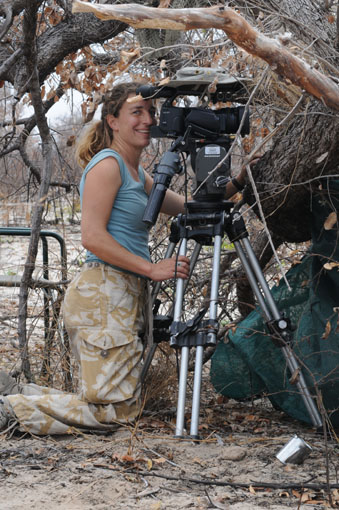
On location in Namibia
The enthusiasm of the first dawn was tangible. We rebuilt the grass hide, destroyed by elephants the night before, and I saw our cameraman Toby Strong plus camera and the two Bushmen hunters, Nao and Kun, creep inside. Their view of the waterhole was good and there were fresh kudu, oryx and ostrich tracks around. Arno, our guide, and I withdrew to observe as safety cover and I set up to film second camera – concentrating on the wildlife shoots, to complement Toby’s main action.
I spent hours crouched on a sloping grass-topped earth bank, craning my neck to see anything that might come into the waterhole without giving myself away. The sun was hot and I was shrouded by a camouflage string scarf which allowed me to see, but broke up my outline. Silence and stillness stretched through the hours. Parts of my body went to sleep, then pins and needles poked me alert again.
It is impossible to remain totally focused when there is precious little to focus on. I found my eyes wandering as I noticed the tiny action going on around my hiding place. Termites in their hundreds were crawling through the grass around me, nipping the stems into tiny lengths and posting it down the holes. Given long enough they would expose me..
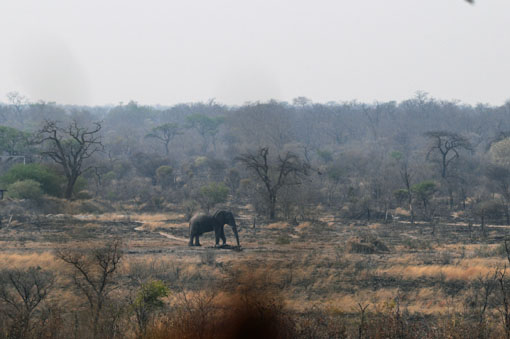
A bull elephant gets dangerously close to the hide (on the right)
It was great to have a role, but I knew I couldn’t jeopardise the crucial shot. If my actions spooked the wildlife, the hunters would not get a chance at their shot, then our story wouldn’t begin. Straining to see ostrich through the camouflage, I froze as they looked in my direction. The camera was recording, though it was above my head and the angle I had to twist to see the screen quickly became painful. I fought the aches, until the giant birds lumbered away.
The first day passed into sunset, without success. By Day Three the enthusiasm had passed, pessimism was rife and the wind had changed. The heat of the first day had been superseded by a blustery wind which carried our smell across the waterhole. This unseasonable weather was not what we needed. When the kudu approached they were edgy, and fewer came because the cooler air reduced their desire to drink.
Yet, slowly they came in, stepping, looking – again I froze. Again the mud bank crumbled under my inclined boots, again I strained to see the screen. With the bright light I couldn’t be sure they were in focus. I cursed and ever so slowly slipped my hand up under the scarf to adjust the camera. It’s tiring on the eyes to look through so many layers of focus: the weave of the scarf, the near grasses masking my face, then the middle distant brush and beyond that the approaching kudu. The concentration is intense. The kudu came closer. But then they stepped into the invisible zone where our smell tainted the air. They stamped, reeled round and were gone. No shot fired. No images today.
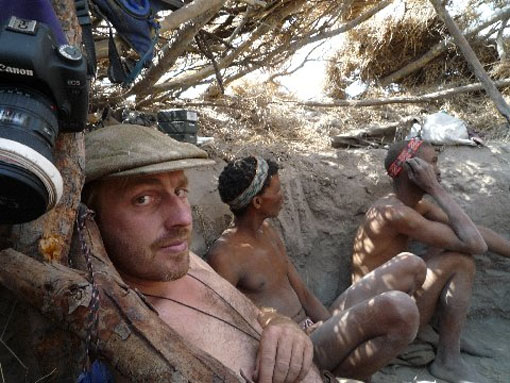
Toby, Nao and Kun in the hide
Day Three did bring a real surprise though. A leopard came into the waterhole at mid day, and it was intrigued by the hide. Slowly, slowly it approached the mound of grass, probably because it saw the potential of this cover as a good place to lie in wait. But the bushmen certainly didn’t want a leopard in the hide with them. Toby, sitting behind then, noticed their buttocks quivering alarmingly. As it wandered to within 20ft they lost their cool, shouted and crawled out of the hide to scare it - Kun pushed the younger Nao out in front of him, then clung to him as they saw off the predator. They didn’t seem such fearless hunters at that moment.
By Day Five we had changed our tactics. The wind had turned again, but the temperature remained low. The hunter’s hide was moved closer in and the morning doves in their hundreds didn’t mind the intrusion – but would the game be as relaxed? Arno and I had backed off further, initially to a distant hide and then the penthouse platform. So far from the action that binoculars were my only connection. But through them I willed the kudu into the waterhole. I was willing them to their death. Was it bloodthirsty, was I hard hearted? I cherish and respect wildlife, so shouldn’t I will the game to flee?
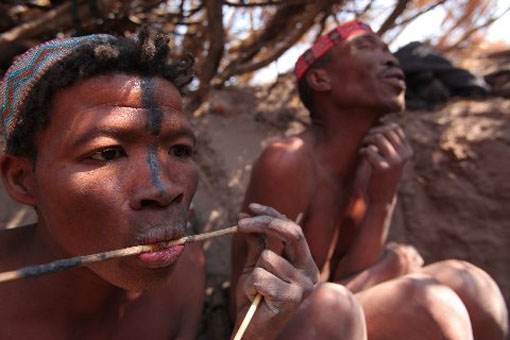
Nao softens the glue to repair an arrow Toby trod on
Though we had asked the bushmen to hunt in our time frame, the fact they were hunting was not unusual. If an animal was killed it would be because of us, yet if we were not there attempting to record the hunt, a different animal would have been taken by the hunters. Any kill is the only meat the bushmen families eat and a carcass provides a feast for the whole village as well as sinew for bow strings and twine, skins for bags and bone marrow to eat as well as knuckle bowls for preparing poison. What Nao and Kun were aiming to do was more honest than my weekly trip to the supermarket. Imagine how far our consumption of meat would go down if we had to sit for a week to catch that lamb or that cow, and then share it amongst our whole community!
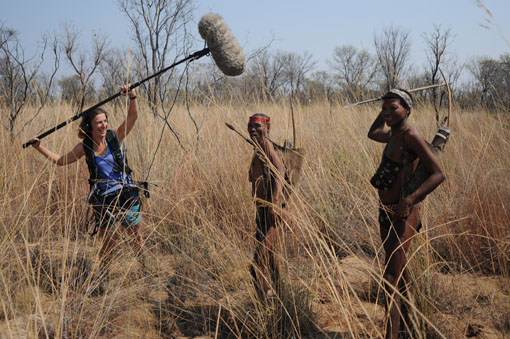
Capturing the sounds of the grasslands
Finally 2 male kudus with statuesque horns sauntered in. They came closer and the wind was kind.. The kudu were alert, frozen, staring at the hide for the longest time. This is your chance guys – do it! do it! I yelled in a whisper inside my head. But the males retreated, grazing close by for over an hour.
I could relax, stretch, move around because I was so far away, but I knew in the hide they would be frozen, silent, stealing glances, easing apart the grasses to make way for a shot. After what seemed like an eternity the males came closer again. Close enough to shoot surely. I saw the kudu react, turn, run, stop and look back. A shot had been fired, but missed. Our waiting continued.
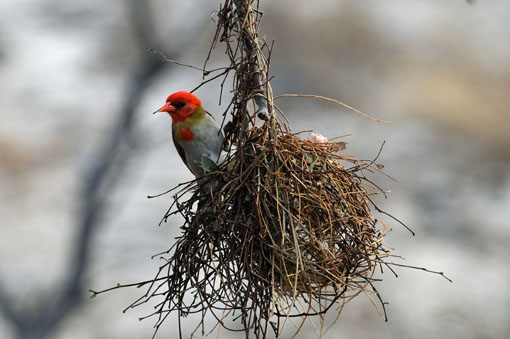
A red headed weaver bird in its 'hide' near our platform lookout
60 hours stretched to near 70 before another opportunity. A group of females were tentative, smelling and sensing something strange, but unsure quite what the nature of the danger was. A warthog ambled into the frame - likely to blow the hunter’s cover with its superior sense of smell. But instead of disaster, he was the perfect decoy. Drinking casually from the waterhole, he was oblivious to the hunters just feet away.
The kudu began to drink, the tension rose as I watched but could not influence events. Just as with the males, I saw them react and flee, but this time the walkie talkie crackled into life ‘It’s a hit, perhaps two’, said Toby, with real elation. The waiting was over.
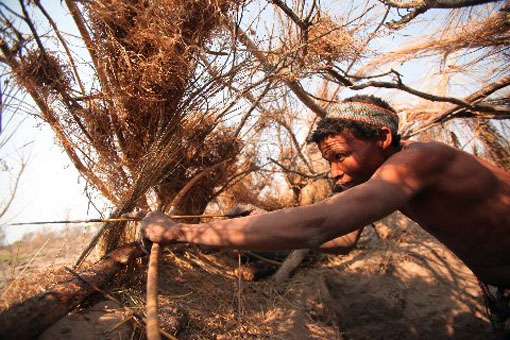
Nao takes aim
Nao had wounded his first kudu. His excitement was genuine and proud. But the hunt was still far from in the can. From here on we were no longer dependent on luck to bring the animals to us, but on the Bushmen’s skills as trackers to keep us on the trail. What we witnessed can be seen in the Grasslands programme, but needless to say – it didn’t go according to plan.
Welcome to Human Planet
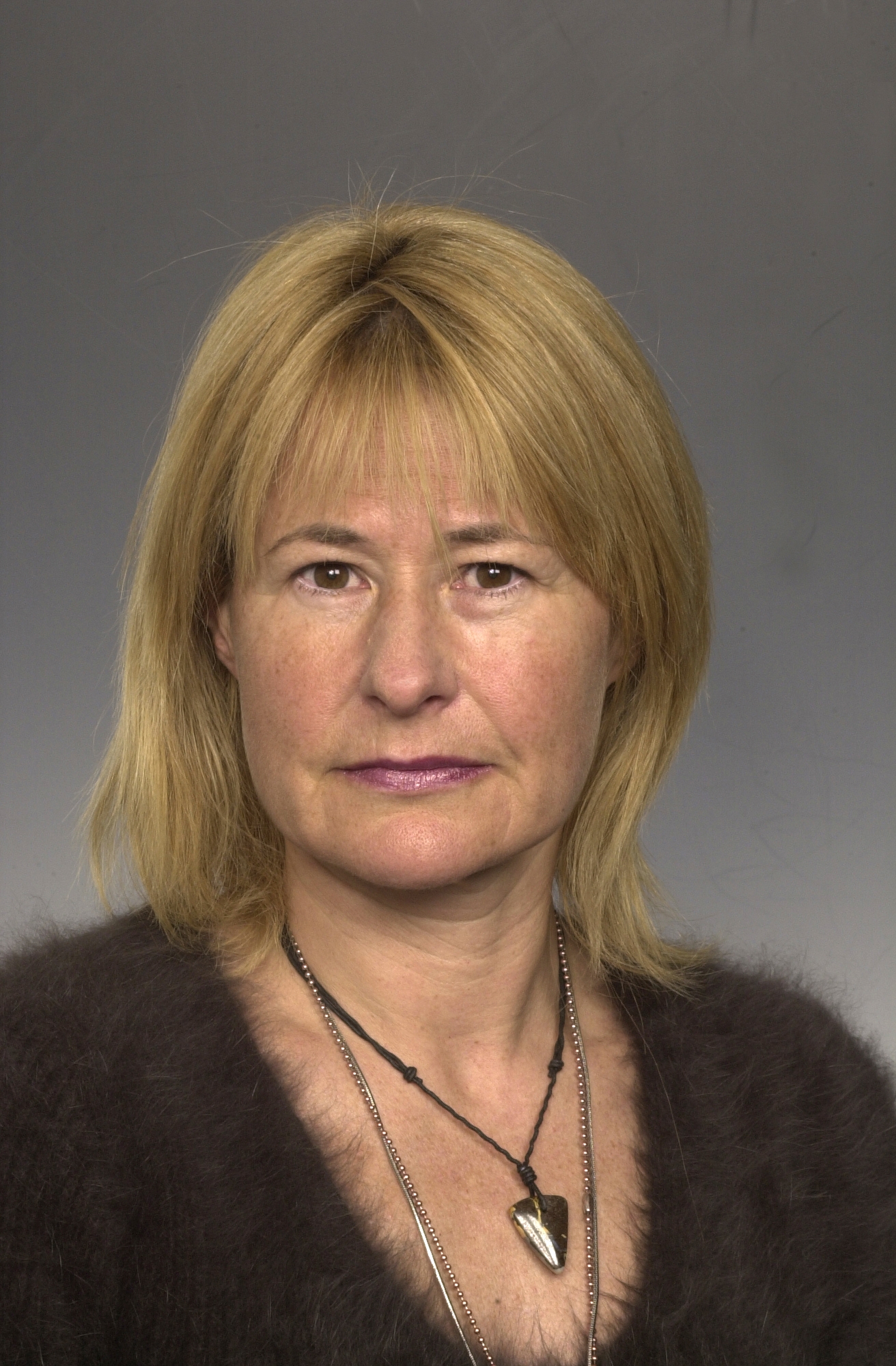
Dale Templar, Series Producer
by Dale Templar, Series Producer
So what is Human Planet? Human Planet is a new 8×50 minute landmark documentary series being made by BBC Television. The series celebrates the human species and looks at our relationship with the natural world by showing the remarkable ways we have adapted to life in every environment on earth. It is due to be transmitted in the UK in the New Year 2011 and will be rolled out across the world soon after.
The production team is split across two sites, one in Bristol and one in Cardiff.
In BBC Bristol we are part of the world renowned Natural History Unit. You may have heard of us, but if not, you’ve probably watched some of our programmes. Many have been presented or narrated by Sir David Attenborough, like Planet Earth and Blue Planet. Most recently we’ve just finished Nature’s Great Events which our own executive producer, Brian Leith, worked on.
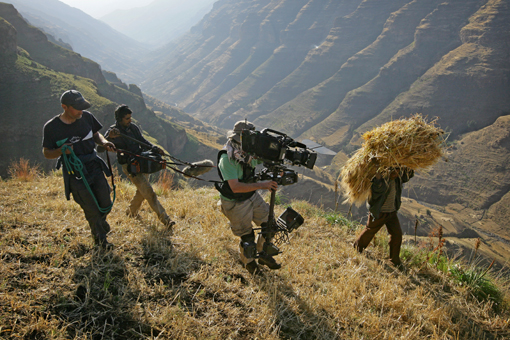
BBC Human Planet : Simien Mountains
BBC Wales, based in Cardiff, are probably best known in the UK right now for producing high end popular dramas like Doctor Who. Torchwood, another sci-fi doc that comes out of Cardiff, is also an HD production and Human Planet will be using the same excellent post-production facilities. The factual department is best known for its ground-breaking anthropology documentary series Tribe.
In total we have a core team of 20 phenomenally talented programme makers, who come with a wide range of skills and experiences. Working with us are some of the best wildlife and documentary camera crews and fixers in the world. For the first time we have a dedicated stills photographer, Timothy Allen, who will be posting his own Human Planet blog every week at http://timothyallen.blogs.bbcearth.com/
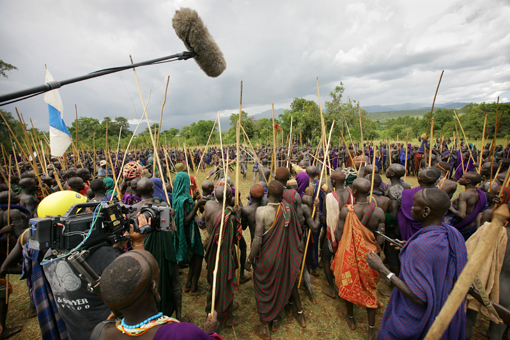
BBC Human Planet : Suri stick fight
The series started in full production in the summer of 2008 and we will be shooting over 70 stories in some of the most remote locations on earth in around 40 different countries.
Each episode will focus on one single environment: desert, jungles, arctic, grasslands, rivers, mountains, oceans and urban. Many of the stories are extremely dramatic and will show how we have successfully adapted and survived in the most challenging places on the planet.
As from next week each member of the team will be blogging their stories from the Human Planet. I will keep you updated on where everyone is and give you general news about the series.
Currently, we have teams that have just come back from the remote southern region of Mongolia, filming for the desert episode. On location are the Jungles and Mountains team who are in the Central African Republic and Nepal. I’ll let you work out which team is where!
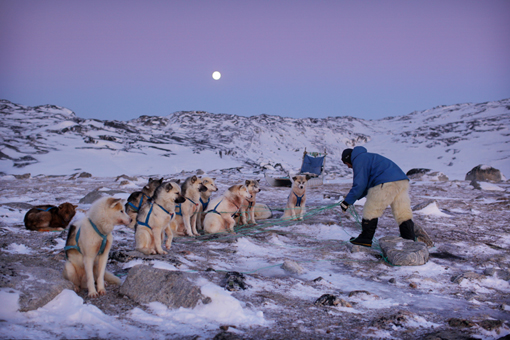
BBC Human Planet : Arctic Dawn
That’s it for now …enjoy the photos and the sneak preview from the series. See the link if you’d like to read what Timothy Allen’s been up to and don’t forget to explore the new BBC Earth site too. Look out for the regular Friday posting from the Human Planet team, with fascinating stories and tales from both our many locations and from the office.
A Grass Calendar
Jane Atkins, Researcher, Deserts/Grasslands team.
A waving white flag is usually a sign for peace, but in the Omo valley it was quite the opposite. In a vast valley of green grasslands and leafy trees these bright flags stood out as bold signs announcing that a violent stick fight was being planned between two villages. It was these incredible stick fights, or Dongas that we hoped to film - but finding out exactly when they would happen was a bit trickier! With only a ten day shoot in this massive valley that stretched to Sudan, we had to find out when each Donga was taking place, and if the chiefs of each village were happy for us to film.
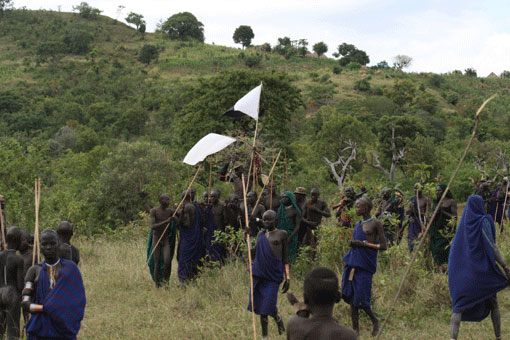
White flags waving
Luckily we were working with Zablon Beyene, an incredible person and wonderful fixer, who introduced us to wise old chiefs and proud confident warriors with smiles.
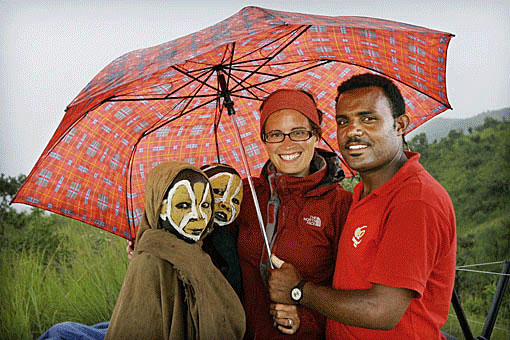
Zablon and I share our umbrella
Over a 5 day recce we walked through villages and valleys to meet Suri elders, sat under shady trees in the heat of the day to talk to young fighters, and sketched out a badly drawn and dusty map of which villages were planning Dongas.
Sitting on the grass, with my map in my dirty hands, we just needed to mark it according to our western agenda of time. Diary planning and meeting deadlines becomes second nature in TV, but here dates were less clear, even to Zab! When we asked the chief when the Donga would happen he picked a long stem of grass, and with dark, leathered hands and tied evenly spaced knots. He explained how each knot represented one day, so the grass stalk handed to us with 8 knots meant the Donga would be on the 8th day. With slight apprehension I translated the dates onto my map, and thanked the chief. Now, after hundreds of handshakes and Suri meetings, all that remained was getting the camera crew to the right location.
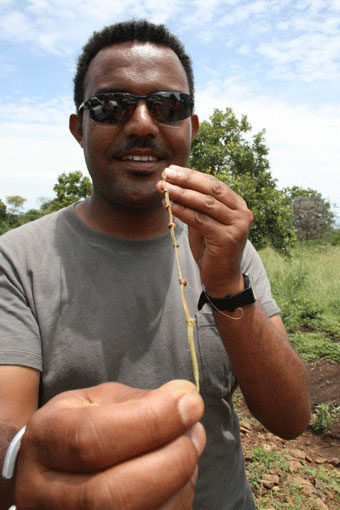
The knotted rope calendar
On the morning of the Donga we walked to the clearing - it was silent, except for the sound of hundreds of dragonflies buzzing around in the sun! 2 hours later, with all our camera kit ready and a crane rigged, we looked at the empty clearing and hoped we’d got the right day after all!
We heard the men coming before we saw them; chants and songs through the trees, getting louder as they approached. Then gun shots! This, Zablon told us, was just guys firing shots into the air to psych themselves up. It worked, as the air was suddenly filled with excitement and adrenaline, as hundreds of men poured into the clearing, waving their sticks. As the crowd circled two posturing fighters, they stabbed a white flag into the ground; the donga had started.
To set the scene our cameraman Mike Fox moved the crane 20 feet into the air to reveal an amazing image of hundreds of men in combat - a scene you’ll never see any where else. We filmed all day, with the crane, then moving hand held amongst the crowds and spectators, and also with an incredible high speed HD camera that captured the force of each fighter. Moving through pumped up crowds, dodging swiping sticks, and ducking from celebratory gun shots were part of the experience and chances we took to film the sequence.
As I led a cameraman into another position I was mistakenly hit by one stick, and as I ran for a new battery I heard the whizzing of a gunshot past my head! The brutality of the Donga really did separate the men from the boys, and was a fascinating insight to the Suri world. As we packed up I was happy that all our planning had paid off, but even happier that we’d all survived!
